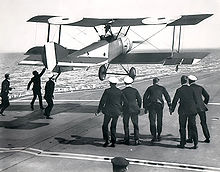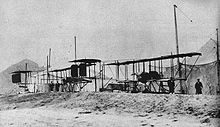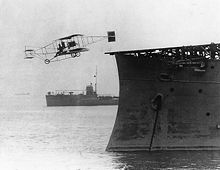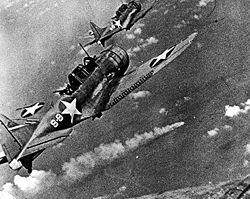- Naval aviation
-
 Sqn. Cdr. E. H. Dunning makes the first landing of an aircraft on a moving ship, a Sopwith Pup on HMS Furious, August 2, 1917.
Sqn. Cdr. E. H. Dunning makes the first landing of an aircraft on a moving ship, a Sopwith Pup on HMS Furious, August 2, 1917.
Naval aviation is the application of manned military air power by navies, including ships that embark fixed-wing aircraft or helicopters. In contrast, maritime aviation is the operation of aircraft in a maritime role under the command of non-naval forces such as the former RAF Coastal Command or a nation's coast guard. An exception to this is the United States Coast Guard, which is considered part of U.S. naval aviation.
Naval aviation is typically projected to a position nearer the target by way of an aircraft carrier. Carrier aircraft must be sturdy enough to withstand demanding carrier operations. They must be able to launch in a short distance and be sturdy and flexible enough to come to a sudden stop on a pitching deck; they typically have robust folding mechanisms that allow higher numbers of them to be stored in below-decks hangars. These aircraft are designed for many purposes including air-to-air combat, surface attack, submarine attack, search and rescue, materiel transport, weather observation, reconnaissance and wide area command and control duties.
Contents
History
 Two of the Imperial Japanese Navy seaplane carrier Wakamiya's Maurice Farman seaplanes stationed on land in Tsingtao in 1914.
Two of the Imperial Japanese Navy seaplane carrier Wakamiya's Maurice Farman seaplanes stationed on land in Tsingtao in 1914.
U.S. naval aviation began with pioneer aviator Glenn Curtiss who contracted with the Navy to demonstrate that airplanes could take off from and land aboard ships at sea. One of his pilots, Eugene Ely, took off from the USS Birmingham (CL-2) anchored off the Virginia coast in November 1910. Two months later Ely landed aboard another cruiser USS Pennsylvania (ACR-4) in San Francisco Bay, proving the concept of shipboard operations. However, the platforms erected on those vessels were temporary measures. The U.S. Navy and Glenn Curtis experienced two firsts during January 1911. On January 27, Curtiss flew the first seaplane from the water at San Diego bay and the next day U.S. Navy Lt Theodore G. “Spuds” Ellyson, a student at the nearby Curtiss School, took off in a Curtiss “grass cutter” plane to become the first Naval aviator. Meanwhile, Captain Henry C. Mustin successfully designed the concept of the catapult launch, and in 1915 made the first catapult launching from a ship underway. Through most of World War I, the world's navies relied upon floatplanes and flying boats for heavier-than-air craft.
Other early operators of seaplanes were France, Imperial Germany and Czarist Russia. The foundations of Greek naval aviation were set in June 1912, when Lieutenant Dimitrios Kamberos of the Hellenic Aviation Service flew with the "Daedalus", a Farman Aviation Works aircraft that had been converted into a seaplane, at an average speed of 110 km per hour, achieving a new world record.[1] Then, on January 24, 1913 the first wartime naval aviation interservice cooperation mission, took place above the Dardanelles. Greek Army First Lieutenant Michael Moutoussis and Greek Navy Ensign Aristeidis Moraitinis, on board the Maurice Farman hydroplane (floatplane/seaplane), drew a diagram of the positions of the Turkish fleet against which they dropped four bombs. This event was widely commented upon in the press, both Greek and international.[2]
WWI and the first carrier strikes
The first strike from a carrier against a land target as well as a sea target took place in September 1914 when the Imperial Japanese Navy seaplane carrier Wakamiya conducted the world's first ship-launched air raids[3] from Kiaochow Bay during the Battle of Tsingtao in China.[4] The four Maurice Farman seaplanes bombarded German-held land targets (communication centers and command centers) and damaged a German minelayer in the Tsingtao peninsula from September until November 6, 1914, when the Germans surrendered.[5]
On the Western front the first naval air raid occurred on December 25, 1914 when twelve seaplanes from HMS' Engadine, Riviera and Empress (cross-channel steamers converted into seaplane carriers ) attacked the Zeppelin base at Cuxhaven. The attack was not a success though a German warship was damaged.
Development in the Interwar period
Genuine aircraft carriers did not emerge beyond Britain until the early 1920s.[6]
In the United States, Billy Mitchell's 1921 demonstration of the battleship-sinking ability of land-based heavy bombers made many United States Navy admirals angry. However, some men, such as Captain (soon Rear Admiral) William A. Moffett, saw the publicity stunt as a means to increase funding and support for the Navy's aircraft carrier projects. Moffett was sure that he had to move decisively in order to avoid having his fleet air arm fall into the hands of a proposed combined Land/Sea Air Force which took care of all the United States's airpower needs. That exact fate had befallen United Kingdom's two air services in 1918; the Royal Flying Corps had been combined with the Royal Naval Air Service to become the Royal Air Force, a condition which would remain until 1937. Moffett supervised the development of naval air tactics throughout the '20s.
Many British naval vessels carried float planes, seaplanes or amphibians for reconnaissance and spotting: two to four on battleships or battlecruisers and one on cruisers. The aircraft, a Fairey Seafox or later a Supermarine Walrus, were catapult-launched, and landed on the sea alongside for recovery by crane. Several submarine aircraft carriers were built by Japan. The French Navy built one large (but ineffective) aircraft carrying submarine, the Surcouf.
World War II
World War II saw the emergence of naval aviation as a significant, often decisive, element in the war at sea. The principal users were Japan, United States (both with Pacific interests to protect) and the United Kingdom. Other colonial powers, e.g. France and the Netherlands, showed a lesser interest. Other powers such as Germany and Italy did not develop independent naval aviation, for geographic or political reasons. Soviet Naval Aviation was mostly organized as land-based coast defense force (apart from some scout floatplanes it consisted almost exclusively of land-based types also used by the Air Force and Air defence units).
During the course of the war, seaborne aircraft were used in fleet actions at sea (Battle of Midway, Bismarck), pre-emptive strikes against naval units in port (Battle of Taranto, Attack on Pearl Harbor), support of ground forces (Battle of Okinawa, Allied invasion of Italy) and anti-submarine warfare (Second Battle of the Atlantic). Carrier-based aircraft were specialized as dive bombers, torpedo bombers, and fighters. Surface-based aircraft such as the PBY Catalina helped finding submarines and surface fleets.
In WWII the aircraft carrier replaced the battleship as the most powerful naval offensive weapons system as battles between fleets were increasingly fought out of gun range by aircraft. The Japanese battleship Yamato, the most powerful battleship ever built, was first turned back by light escort carrier aircraft, and later sunk lacking its own air cover.
The US launched normally land-based bombers from carriers in a raid against Tokyo. Smaller carriers were built in large numbers to escort slow cargo convoys or supplement fast carriers. Aircraft for observation or light raids were also carried by battleships and cruisers, while blimps were used to search for attack submarines.
Experience showed that there was a need for widespread use of aircraft which could not be met quickly enough by building new fleet aircraft carriers. This was particularly true in the north Atlantic, where convoys were highly vulnerable to U-boat attack. The British authorities used unorthodox, temporary, but effective means of giving air protection such as CAM ships and merchant aircraft carriers, merchant ships modified to carry a small number of aircraft. The solution to the problem were large numbers of mass-produced merchant hulls converted into escort aircraft carriers (also known as "jeep carriers"). These basic vessels, unsuited to fleet action by their capacity, speed and vulnerability, nevertheless provided air cover where it was needed.
The Royal Navy had observed the impact of naval aviation and, obliged to prioritise their use of resources, abandoned battleships as the mainstay of the fleet. HMS Vanguard was therefore the last British battleship and her sisters were cancelled. The United States had already instigated a large construction programme (which was also cut short) but these large ships were mainly used as anti-aircraft batteries or for shore bombardment.
Other actions involving naval aviation included:
- Battle of the Atlantic, aircraft carried by low-cost escort carriers were used for antisubmarine patrol, defense, and attack.
- At the start of the Pacific War in 1941, Japanese carrier-based aircraft sank many US warships at Pearl Harbor and land-based aircraft sank two large British warships. Engagements between Japanese and American naval fleets were then conducted largely or entirely by aircraft - examples include the battles of Coral Sea, Midway, Bismarck Sea and Philippine Sea.[7]
- Battle of Leyte Gulf, with the first appearance of kamikazes, perhaps the largest naval battle in history. Japan's last carriers and pilots are deliberately sacrificed, a battleship is sunk by aircraft.
- Operation Ten-Go demonstrated U.S. air supremacy in the Pacific theater by this stage in the war and the vulnerability of surface ships without air cover to aerial attack.
Roles
Strategic projection
Carrier-based naval aviation provides a country's seagoing forces with air cover over areas that may not be reachable by land-based aircraft, giving them a considerable advantage over navies composed primarily of surface combatants.
In the case of the United States Navy during and after the Cold War, virtual command of the sea in many of the world's waterways allowed it to deploy aircraft carriers and project air power almost anywhere on the globe. By operating from international waters, U.S. carriers can bypass the need for conventional airbases or overflight rights, both of which can be politically difficult to acquire.
Anti-submarine
During the Cold War, the navies of NATO faced a significant threat from Soviet submarine forces, specifically Soviet Navy SSN and SSGN assets. This resulted in the development and deployment of light aircraft carriers with major anti-submarine warfare (ASW) capabilities by European NATO navies. One of the most effective weapons against submarines is the ASW helicopter, several of which could be based on these light aircraft carriers. These light carriers were typically around 20,000 tons displacement and carried a mix of ASW helicopters and BAe Sea Harrier or Harrier II V/STOL aircraft.
- Argentine Naval Aviation
- Brazilian Naval Aviation
- Fleet Air Arm (RAN)
- Fleet Air Arm (Royal Navy)
- French Naval Aviation
- Indian Naval Air Arm
- Marineflieger (German navy)
- Mexican Naval Aviation
- Pakistan Naval Air Arm
- People's Liberation Army Naval Air Force
- Peruvian Naval Aviation
- Russian Naval Aviation
- United States Naval Aviator
Since 1975 the Royal Canadian Navy's naval aviation arm is operated by the Air Command.See also
- Military aviation
- Aircraft carrier
- Escort carrier
- Carrier-based aircraft
- Flying boat
- Seaplane
- Aerial warfare
- Modern US Navy carrier air operations
References
- ^ Hellenic Air Force History - The first Steps
- ^ Hellenic Air Force History - Balcan Wars
- ^ Wakamiya is "credited with conducting the first successful carrier air raid in history"Source:GlobalSecurity.org, also "the first air raid in history to result in a success" (here)
- ^ "Sabre et pinceau", Christian Polak, p92
- ^ IJN Wakamiya Aircraft Carrier
- ^ [1]
- ^ Boyne (2003), pp.227–8
- Clark G. Reynolds, The fast carriers: the forging of an air navy (1968; 1978; 1992)
- William F. Trimble, Hero of the Air: Glenn Curtiss and the Birth of Naval Aviation (2010)
External links
Lists relating to aviation General Aircraft (manufacturers) · Aircraft engines (manufacturers) · Airlines (defunct) · Airports · Civil authorities · Museums · Registration prefixes · Rotorcraft (manufacturers) · TimelineMilitary Accidents/incidents Records Categories:
Wikimedia Foundation. 2010.



